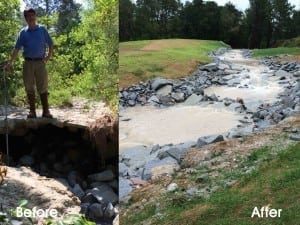Creek restoration project in Northeast Richland County wins engineering award
November 15, 2016Little Jackson Creek in Northeast Richland County is getting a much-needed makeover to help control flooding, improve water quality and better protect its surrounding natural habitat.
From its headwaters in the Spring Valley subdivision to its confluence with Jackson Creek near Dentsville, Little Jackson Creek flows for nearly five miles. Over the past few decades, sections of the meandering waterway have transformed into deep ditches, leading to severe erosion and an impaired aquatic habitat. These detrimental changes are a result of the watershed’s highly impervious, pre-regulation development and urban stormwater runoff, as well as damage from the October 2015 flood.
Richland County’s Conservation Department and the Spring Valley Homeowners Association recognized the need to repair the waterway. The entities sought the expertise of WK Dickson, a community infrastructure consulting firm, to help return Little Jackson Creek to its former self.
Today, more than 1,500 feet of the creek and nearly nine acres of surrounding wetlands have been successfully restored.
“This project is an incredible example of how multiple organizations and funding sources can work together to restore streams and wetlands,” said Richland County Conservation Director Quinton Epps.
Ninety percent of the design and construction costs of the restoration project were funded by an Airport Improvement Program Grant from the Federal Aviation Administration. The remaining 10 percent was funded equally by a grant from the S.C. Aeronautics Commission and the County’s Jim Hamilton-L.B. Owens Airport operating budget. This unusual funding partnership was the result of a need for the airport to mitigate wetlands impact from a recently completed runway project. Since the airport is located within the same watershed as Little Jackson Creek, restoring the damaged creek seemed like the perfect fit.
“This was the classic ‘win-win,’” said Airport Director Chris Eversmann. “It took some effort, but we were able to improve the airport, address a longstanding stormwater management problem and do it with mostly federal and state grant funds.”
The Little Jackson Creek project included creating two regenerative stormwater conveyances, which are a fairly new and innovative approach to stormwater treatment and stream restoration. A regenerative stormwater conveyance is a series of riffles and pools designed in a specific way that limits erosion and reduces the amount of sediment and pollutants that enter receiving waters. High levels of sediment negatively affect water quality and disrupt the area’s natural ecological balance.
The restoration project began in June and is expected to be complete in December.
“We are happy this aspect of the three-pronged project is already showcasing benefits for downstream inhabitants and the local property owners,” said Renée Gardner, president of the Spring Valley Homeowners Association. “We look forward to the subsequent collateral project work of sediment removal and upditch remediation to fully realize the award-winning efforts made by the project group as a whole.”
The complexities of the project and its notable positive effects have garnered the attention of professional engineers and conservationists. WK Dickson recently received an Engineering Excellence Award for the Little Jackson Creek Mitigation Project from the American Council of Engineering Companies of North Carolina, where the consulting firm is headquartered.
“It has been a pleasure working with Richland County on this unique and often challenging project,” said Ward Marotti, Senior Project Manager for WK Dickson. “It is the first of its kind for a community that continues to prioritize its interest and commitment to finding new and innovative ways to protect its citizens and the environment, while simultaneously maintaining careful stewardship of its financial resources.”
Richland County Councilman Jim Manning has been a proponent of the restoration project since its inception. Portions of District 8, which Manning represents, lie within the Gills Creek Watershed.
“Joint efforts like this really spotlight the successes than can be achieved when County departments and residents work in tandem toward a common goal,” Manning said. “The positive results of the Little Jackson Creek restoration project can already be seen and will continue for years to come.”












